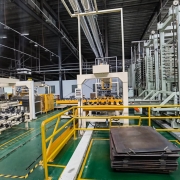Jak wybrać odpowiedni szablon, który spełni wymagania SMT?
Jak wybrać odpowiedni szablon, który spełni wymagania SMT?
Jeśli planujesz wykonać szablon do projektu technologii montażu powierzchniowego, powinieneś zapoznać się z kilkoma czynnikami, które mogą pomóc w podjęciu decyzji o szablonie, którego potrzebujesz. Czynniki te to cena, kształt i wymiary. Uwzględnienie tych czynników pomoże dokonać najlepszego wyboru.
Wymiary
Szablon musi mieć odpowiednie wymiary, aby pomieścić na nim dane płytki. Nazywa się to obszarem efektywnym. Jest to centralna część szablonu, którą można wyciąć w celu dopasowania do padów na płytce SMT. Pozostała przestrzeń wokół szablonu nazywana jest marginesem szablonu. Szablonu nie można wyciąć poza ten obszar.
Istnieje pięć głównych rodzajów technologii szablonów SMT. Obejmują one cięcie laserowe, elektroformowanie, wytrawianie chemiczne i hybrydowe. Chemicznie wytrawiane szablony metalowe są bardzo przydatne w przypadku szablonów krokowych. Szablony te są chemicznie frezowane po obu stronach, a rezultatem jest prawie prosta ściana z lekkim kształtem klepsydry w środku.
Tekstura
Istnieje wiele dostępnych opcji, jeśli chodzi o szablony. Możesz kupić szablony lub wykonać je samodzielnie. Szablon to wzór wycięty za pomocą plotera. Jakość i rozmiar szablonu zależy od ustawień plotera. Przed wycięciem szablonu należy upewnić się, że ustawienia siły i prędkości są prawidłowe. Siła powinna być wystarczająca do przecięcia winylu bez uszkodzenia lepkiego podkładu. Prędkość powinna być wystarczająco duża, aby szablon został wycięty tak szybko, jak to możliwe. Zbyt szybkie cięcie może jednak spowodować rozdarcie rogów prostokątów.
Szablony stosowane w technologii montażu powierzchniowego są zwykle wykonane z folii ze stali nierdzewnej. Są one wycinane za pomocą lasera w celu dopasowania do urządzenia montowanego powierzchniowo. Szablony te są umieszczane na płytce i służą do nakładania pasty lutowniczej. Szablon pozwala na dokładne umieszczenie pasty lutowniczej bez konieczności pracy ręcznej. Ponadto szablon oszczędza czas i wysiłek.
Cena
Kupując szablony, klient musi zadbać o to, aby znaleźć taki, który jest odpowiedni dla jego wymagań. Należy wziąć pod uwagę dwa główne czynniki: grubość szablonu i dane płytki. Grubość szablonu pomoże w uwalnianiu pasty z płytki. Co więcej, rozmiar szablonu musi mieścić się w obszarze efektywnym (EA), który jest centralną częścią szablonu. Pozostała część szablonu nazywana jest marginesem, którego nie można wyciąć.
Rozmiar szablonu jest ważnym parametrem dla każdej automatycznej drukarki pasty lutowniczej. Różne płytki PCB mają różne rozmiary wewnętrzne, a szablon musi być dostosowany do rozmiaru ramki drukarki.
Dostępność
Szablony są doskonałą opcją dla różnych projektów dekoracyjnych. Niezależnie od tego, czy malujesz pokój, czy dodajesz unikalny wzór do mebla, szablony mogą zapewnić czysty, wyraźny obraz. W przeciwieństwie do pędzla, szablony są wielokrotnego użytku i będą służyć przez lata.

